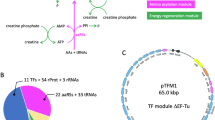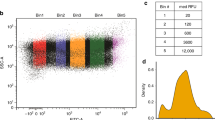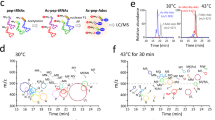Abstract
Peptide chain release factors are soluble proteins that participate in the stop codon-dependent termination of polypeptide biosynthesis. In Escherichia coli, two release factors are necessary for peptide chain termination: release factor 1 (RF1) specifies UAG-and UAA-dependent termination whereas release factor 2 (RF2) specifies UGA- and UAA-dependent termination1. Release factors are found in low concentrations relative to other translation factors2, suggesting that their expression is tightly regulated and, accordingly, making the study of their structure–function relationship difficult. RF1 and RF2 exhibit significant sequence homology, probably reflecting their similar functions and perhaps a common evolutionary origin3. DNA and peptide sequencing have suggested the existence of a unique mechanism for the autogenous regulation of RF2 in which an in-frame UGA stop codon requires an obligatory +1 frameshift within the coding region of the RF2 gene. In this report we present in vitro experimental results consistent with the autogenous regulation of RF2. Additionally, we used RF2-lacZ gene fusions to demonstrate that autogenous regulation occurs, at least in part, by premature termination at the in-frame stop codon, since deletion of this stop codon leads to overproduction of the RF2–LacZ fusion protein. Frameshifting at this premature termination codon occurs at the remarkably high rate of 50%.
This is a preview of subscription content, access via your institution
Access options
Subscribe to this journal
Receive 51 print issues and online access
$199.00 per year
only $3.90 per issue
Buy this article
- Purchase on Springer Link
- Instant access to full article PDF
Prices may be subject to local taxes which are calculated during checkout
Similar content being viewed by others
References
Caskey, C. T. Trends biochem. Sci. 5, 234–237 (1980).
Klein, H. A. & Capecchi, M. R. J. biol. Chem. 256, 1055–1061 (1971).
Craigen, W. J., Cook, R. G., Tate, W. P. & Caskey, C. T. Proc. natn. Acad. Sci. U.S.A. 82, 3616–3620 (1985).
Scolnick, E., Tompkins, R., Caskey, T. & Nirenberg, M. Proc. natn. Acad. Sci. U.S.A. 61, 768–774 (1968).
Nomura, M., Jinks-Robertson, S. & Miura, A. in Interaction of Translational and Transcriptional Controls in the Regulation of Gene Expression (eds Grunberg-Manago, M. & Safer, B.) 91–104 (Elsevier, Amsterdam, 1982).
Weiss, R. Proc. natn. Acad. Sci. U.S.A. 81, 5797–5801 (1984).
Weiss, R. & Gallant, J. Genetics (in the press).
Bossi, L. J. molec. Biol. 164, 73–87 (1983).
Murgola, E. J., Pagel, F. T. & Hijazi, K. A. J. molec. Biol. 175, 19–27 (1984).
Carrier, M. J. & Buckingham, R. H. J. molec. Biol. 175, 29–38 (1984).
Dunn, J. J. & Studier, F. W. J. molec. Biol. 166, 477–535 (1983).
Jacks, T. & Varmus, H. E. Science 230, 1237–1242 (1985).
Clare, J. & Farabaugh, P. Proc. natn. Acad. Sci. U.S.A. 82, 2829–2833 (1985).
Atkins, J. F., Elseviers, D. & Gorini, L. Proc. natn. Acad. Sci. U.S.A. 69, 1192–1196 (1972).
Caskey, C. T., Scolnick, E., Tomkins, R., Milman, G. & Goldstein, J. Meth. Enzym. 20, 367–375 (1971).
Caskey, C. T., Forrester, W. C., Tate, W. P. & Ward, C. J. Bact. 158, 365–368 (1984).
Miller, J. H. Experiments in Molecular Genetics, 355 (Cold Spring Harbor Laboratory, New York, 1972).
Uhlin, B. E. & Nordström, K. Plasmid 1, 1–8 (1977).
Author information
Authors and Affiliations
Rights and permissions
About this article
Cite this article
Craigen, W., Caskey, C. Expression of peptide chain release factor 2 requires high-efficiency frameshift. Nature 322, 273–275 (1986). https://doi.org/10.1038/322273a0
Received:
Accepted:
Issue Date:
DOI: https://doi.org/10.1038/322273a0
This article is cited by
-
The distinct translational landscapes of gram-negative Salmonella and gram-positive Listeria
Nature Communications (2023)
-
A workflow to identify novel proteins based on the direct mapping of peptide-spectrum-matches to genomic locations
BMC Bioinformatics (2021)
-
Structural basis for +1 ribosomal frameshifting during EF-G-catalyzed translocation
Nature Communications (2021)
Comments
By submitting a comment you agree to abide by our Terms and Community Guidelines. If you find something abusive or that does not comply with our terms or guidelines please flag it as inappropriate.



